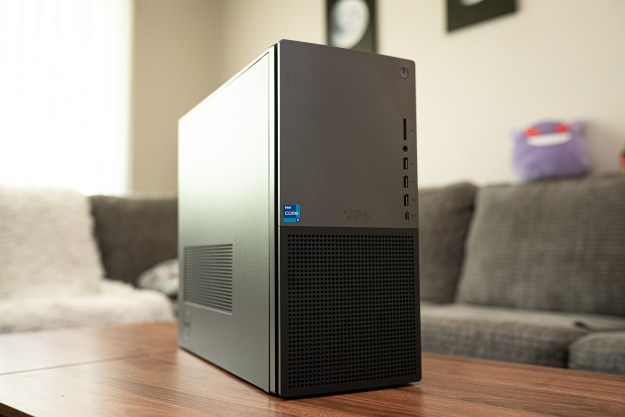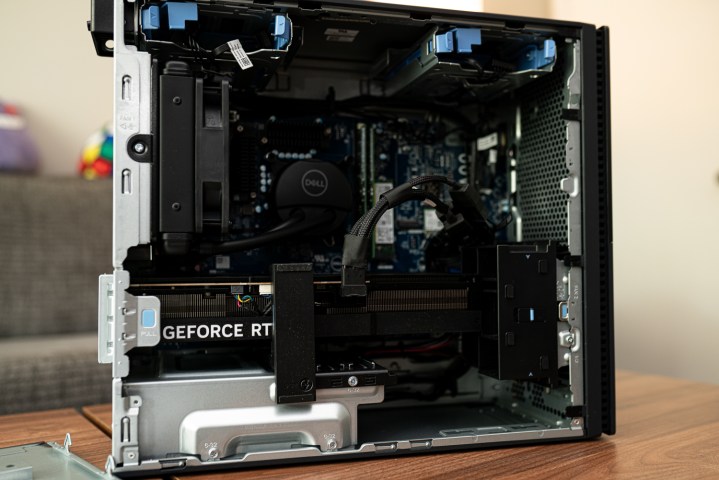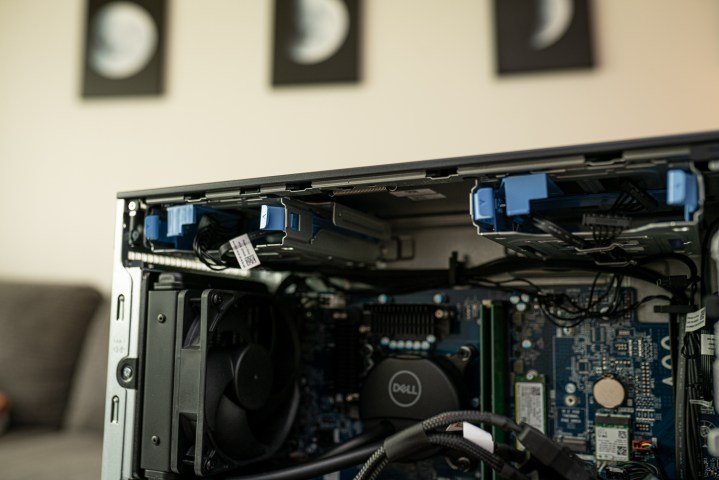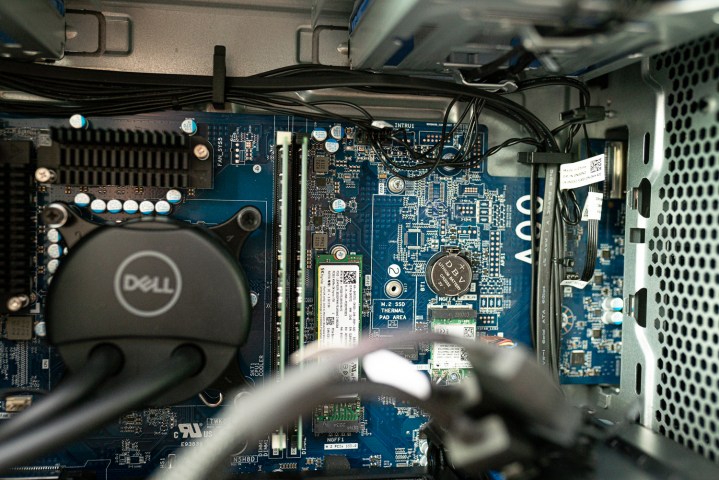
“The new Dell XPS Desktop delivers a new class of performance, but it comes at the cost of flexibility.”
- Flagship performance
- Understated, attractive design
- Relatively quiet
- Solid port selection
- Limited upgrade potential
- Expensive
Dell didn’t need to change the XPS Desktop. It was already one of the best desktops you can buy, so instead of fixing what wasn’t broken, the Dell XPS Desktop 8960 simply pushes performance forward.
Equipped with 13th-gen Intel CPUs and Nvidia RTX 40-series GPUs, the new range keeps a familiar design while pushing into a new class of performance. Despite its unassuming exterior, the XPS Desktop delivers a flagship gaming and creator experience. In that process, however, it has lost some of the flexibility that made last-gen’s model so attractive.
Dell XPS Desktop (8960) specs

The strength of the Dell XPS Desktop is its ability to be a performance chameleon, but the latest update changes that. Currently, Dell is only offering high-end configurations, rather than a large swath of spec sheets that made the previous iteration so special.
My review unit is the cheapest model you can currently buy, outfitted with a Core i7-13700K and RTX 4080 graphics card. That’s a supremely power configuration, bypassing even the most expensive option from the previous generation. Another significant change is that Dell includes unlocked Intel processors by default; previously, an unlocked CPU was a $100 upcharge.
| CPU | Intel Core i7-13700K |
| GPU | Nvidia RTX 4080 |
| Motherboard | Custom Dell motherboard |
| Case | Custom Dell XPS case |
| Memory | 32GB DDR5-4800 (2 x 16GB) |
| Storage | 1TB NVMe SSD |
| Power supply | Custom Dell 750W PSU |
| USB ports | 5x USB 3.2 Type-A, 2x USB 2.0 Type-A, 2x USB-C, 1x SD card reader, |
| Networking | 2.5Gigabit Ethernet, Wi-Fi 6E, Bluetooth 5.2 |
| Price | $2,850 |
It shouldn’t come as a surprise that a boost in specs comes with a boost in price, but it’s the scale of the price increase that’s shocking. Even the cheapest iteration of the newest model is $300 more than the most expensive configuration of the previous generation. The 8960 can scale much higher, too. You can pack in up to a Core i9-13900K, RTX 4090, 6TB of SSD storage, and 64GB of DDR5 memory. That will run you over $5,000.
Dell is offering the configuration I reviewed for $2,850. That’s not a terrible price compared to high-end gaming desktops like the Alienware Aurora R15 that pack similar specs. But it’s still a far cry from the class the Dell XPS Desktop used to fall in.
It’s not all bad. Dell continues to offer the previous version with Intel 12th-gen processors and Nvidia RTX 30-series GPUs, and both models carry the same chassis otherwise. I’m just worried about where the cheaper configurations of the 8960 will end up when they’re inevitably released. Based on the configurations we have now, it’s not hard to assume they’ll be much more expensive.
The ultimate sleeper PC

The Dell XPS Desktop 8960 is an internal upgrade, so it carries the same case as the previous generation. It’s sleek and understated, coming in either Platinum or Graphite, and it looks unassuming considering the hardware you can pack inside.
This is true even more so this generation, when you can cram in the flagship options from Nvidia and Intel. It’s the ultimate sleeper PC, ditching RGB lighting and a massive case in favor of a subdued design and smart airflow.
I say “smart” because the XPS Desktop 8960 doesn’t have a lot of fans. You get two 120mm fans total, split across a 120mm intake in the front and 120mm exhaust in the rear. Dell manages how the air flows throughout the case, though. The intake is channeled into the graphics card through a bracket, cooling it first and exhausting the heat inside the case. Then, the liquid cooler deals with managing the heat of the processor while exhausting the leftover air out the back.
Dell manages the heat, but the XPS Desktop 8960 can still get loud. Due to only having a couple of fans, the machine will ramp up very loud for brief sprints while under stress, rather than the consistent hum of a PC with more fans. Noise is no dealbreaker here, though.

My main concern is maintenance. Although Dell manages heat and noise well, there aren’t any dust filters in the machine. Instead, you have the dated raw aluminum look inside that’s waiting to be caked in a layer of dust and painstakingly cleaned out with compressed air. A dust filter would help a lot, especially considering the focused air path Dell has carved out.
Although the case is the same as the previous version of the XPS Desktop, Dell made one important change. There’s no longer a disc drive, so if you’ve been hanging onto CDs and DVDs, you’ll need an external reader to use them with the updated machine.
Upgradability

The XPS Desktop has never been friendly to major upgrades, and the 8960 revision carries the same proprietary components as previous models. You can’t swap out the motherboard or power supply, but thankfully, Dell now offers a 1,000-watt power supply option if you want to upgrade some components in the future.
I’m split when it comes to upgrades. On one hand, Dell offers some convenient upgrade spots inside the machine that even novice builders can use. There’s a spare M.2 SSD slot if you opt not to fill it when configuring the machine, for example, and the two drive sleds on top of the case have SATA cables already routed to them.
On the other hand, the GPU has a massive bracket around it, preventing simple upgrades, and there are only two RAM slots (both of which are filled in every configuration).
The case isn’t particularly friendly to upgrades, either. It features a toolless entry, where pulling a lever will snap off the side panel, but you can’t remove the other side panel. That makes managing your cables tough if you add another drive into the machine.
I appreciate that Dell has made an effort to allow you to upgrade the XPS Desktop, but it still feels like more could be done. As it stands now, the machine can only mature to the point of the motherboard, meaning it has a limited shelf life.
CPU power

Despite its unassuming look, the XPS Desktop 8960 is one of the most powerful desktops you can buy right now. The Core i7-13700K is a 16-core processor from Intel’s most recent generation, and when paired with the latest DDR5 memory, can tear through the most demanding tasks you can throw at a PC.
You can see that in action in my results below. In raw CPU power, the Core i7-13700K still sits behind Intel’s most recent flagship, but it offers better single and multi-core performance than last-gen’s Core i9-12900K. That’s true in Cinebench and Geekbench, the latter of which is typically a little more representative of real-world performance differences.
| Dell XPS Desktop 8960 (Core i7-13700K) | Lenovo Legion Tower 7i (Core i9-13900KF) | HP Omen 45L (Core i9-12900K) | |
| Cinebench R23 Multi-Core | 24,061 | 36,783 | 23,068 |
| Cinebench R23 Single-Core | 2,087 | 2,171 | 1,893 |
| Geekbench 5 Multi-Core | 17,486 | 21,742 | 15,685 |
| Geekbench 5 Single-Core | 1,974 | 2,095 | 1,910 |
| PugetBench for Premiere Pro | 1,426 | 1,242 | 1,025 |
| Blender Monster (GPU) | 4,752 | 4,913 | N/A |
| Blender Junkshop (GPU) | 2,352 | 2,415 | N/A |
| Blender Classroom (GPU) | 2,259 | 2,309 | N/A |
In creative applications, the XPS Desktop 8960 is a monster. It actually outperformed the Lenovo Legion Tower 7i and its more powerful processor in PugetBench for Premiere Pro.
The main reason why is Intel Quick Sync. The Core i7-13700K has integrated graphics while the Core i9-13900KF does not. Some apps, such as Premiere Pro, allow you to use both the discrete and integrated graphics to accelerate performance, and the XPS Desktop 8960 shows off what those gains can look like.
You don’t spend nearly $3,000 for just a processor, though. Blender shows the powerful RTX 4080 off in action. It wasn’t quite as powerful as the RTX 4080 inside the Lenovo Legion Tower 7i, likely due to some thermal constraints. If the performance is too low, you can configure the XPS Desktop 8960 with the RTX 4090, as well.
That’s one of the pressing issues with the Dell XPS Desktop. It manages heat well and doesn’t get too loud, but it’s packing much more powerful hardware in a case built for the previous generation. Thankfully, you have liquid cooling with higher-end processors like the Core i7-13700K, but it’s only a 120mm cooler. That limits the potential of overclocking compared to some of the best AIO coolers.
There’s no doubt that the XPS Desktop 8960 is a supremely powerful PC, but it ships at its performance limit. You don’t have any headroom to squeeze out extra performance like you can on a machine like the HP Omen 45L or Lenovo Legion Tower 7i that offer larger liquid cooling and larger cases.
Graphics power

The XPS Desktop 8960 doesn’t look like a gaming PC, but make no mistake; it’s one of the best gaming desktops you can buy. The RTX 4080 at the heart of the machine is a powerful GPU capable of running the most demanding games on the market at 4K, and you can see that in my results below.
| Dell XPS Desktop 8960 (Core i7-13700K) | Lenovo Legion Tower 7i (RTX 4080) | Custom RTX 4080 desktop (Ryzen 9 7950X) | |
| Cyberpunk 2077 (4K Ultra) | 62 fps | 62 fps | 58.9 fps |
| Cyberpunk 2077 (4K Ultra RT) | 27 fps | 29 fps | 29 fps |
| Red Dead Redemption 2 (4K Ultra) | 98 fps | 97 fps | 97.2 fps |
| Forza Horizon 5 (4K Ultra) | 128 fps | 136 fps | 133.7 fps |
| Assassin’s Creed Valhalla (4K Ultra High) | 98 fps | 100 fps | 98.4 fps |
| Gears Tactics (4K Ultra) | 103 fps | 108 fps | 103.8 fps |
| 3DMark Time Spy | 24,592 | 24,554 | 25,402 |
It actually ended up slightly faster than a custom RTX 4080 desktop with a Ryzen 9 7950X, and that machine was built on an open-air test bench. Again, thermal constraints are a concern if you want to dabble in overclocking, but clearly the smaller size of the XPS Desktop 8960 isn’t hindering its performance out of the box.
The RTX 4080 also carries DLSS 3, which uses AI to generate frames in supported games. It can massively improve performance in supported games like Cyberpunk 2077, even with ray tracing turned on. It didn’t reach quite the heights of the Lenovo Legion Tower 7i, but it was close.
| Dell XPS Desktop 8960 (Core i7-13700K) | Lenovo Legion Tower 7i (RTX 4080) | |
| Cyberpunk 2077 4K Ultra RT | 27 fps | 29 fps |
| Cyberpunk 2077 4K Ultra RT w/ DLSS 3 | 108 fps | 115 fps |
One of the best parts of the Dell XPS Desktop has always been its ability to switch gears between gaming and intensive compute work without breaking a sweat, and the 8960 revision is no different. It reaches a different performance class this time around, though, offering flagship 4K gaming performance rather than simply dabbling.
Light on bloat
Dell is light on bloatware, which I always appreciate. There wasn’t an additional antivirus installed, so you won’t get endless advertisements for Norton or McAfee, and Dell’s own utilities are useful as always. The most important one is Dell Update, which will automatically search for updates for your entire PC and install them. The only thing it didn’t catch was the graphics driver, but Nvidia’s GeForce Experience comes preinstalled to apply that.
Dell doesn’t load your machine up with bloatware, and that’s a win.
My only issue, which is consistent with Dell machines, is that there isn’t a way to find all of the disparate apps. They’re all useful, but short of simply searching “Dell,” you won’t know what’s available to you. Worse, there’s a MyDell app that looks like a hub, but it just lets you install apps included with your PC, such as the Killer Network set. It’s a minor complaint overall, though. Dell doesn’t load your machine up with bloatware, and that’s a win.
The warranty includes hardware support for one year, with repairs either in-home or at an authorized repair center. It doesn’t cover accidental damage, though; that’s a $70 upcharge. You can purchase up to four years of coverage with either Premium or Premium Plus support, which will run you $350 and $700 for four years, respectively.
A new performance class

The Dell XPS Desktop 8960 can handle the hardware packed inside, but it’s in a much different performance class than the previous model. Newer, cheaper configurations will show up eventually, but those looking for a solid all-around desktop are better off picking up an 8950 model for now.
On the other hand, performance chasers now have access to a class of hardware that wasn’t previously available in this design. The 8960 delivers flagship 4K gaming performance and can even dethrone powerful creator PCs.







